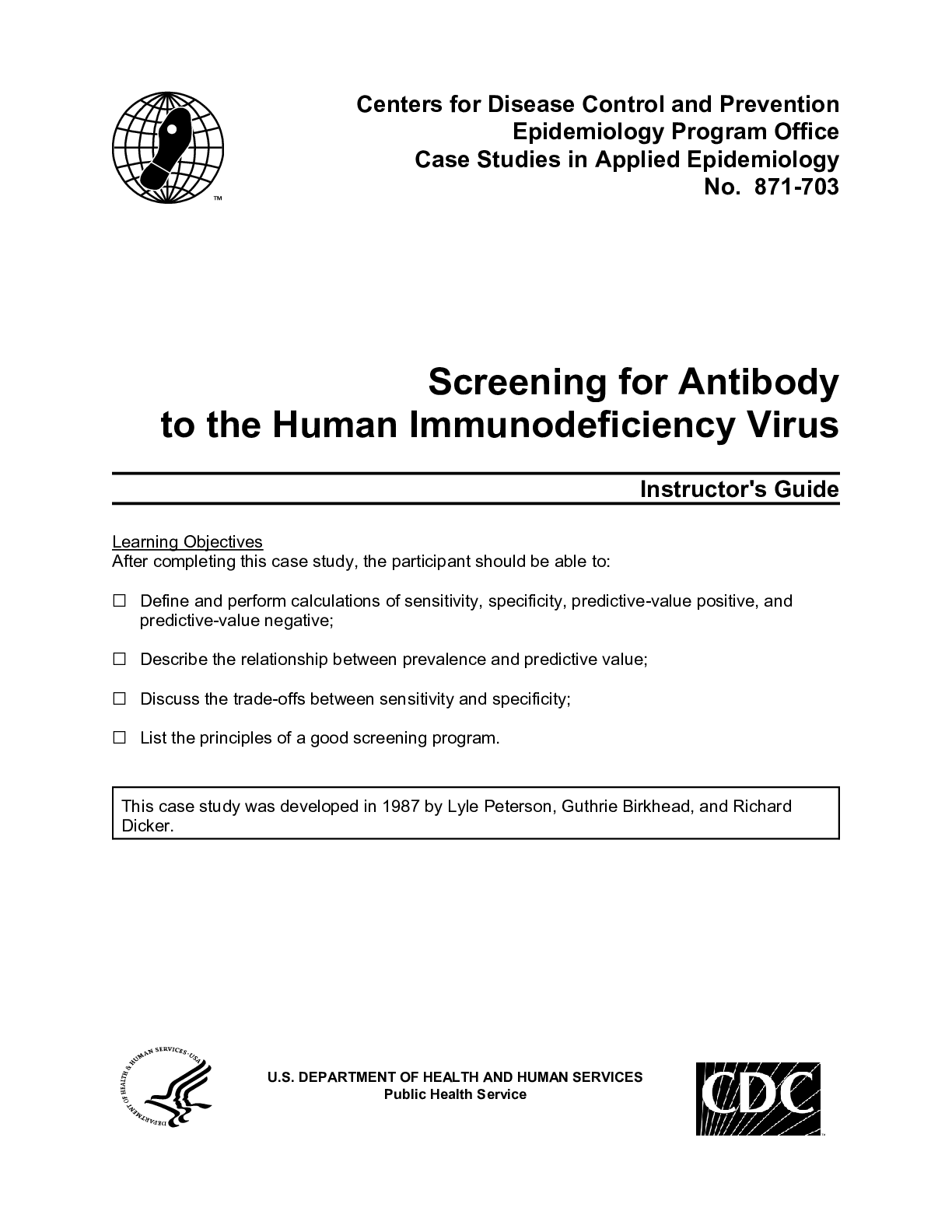Learning Objectives
After completing this case study, the participant should be able to:
G Define and perform calculations of sensitivity, specificity, predictive-value positive, and
predictive-value negative;
G Describe the relationship between prevalence and predictive value;
G Discuss the trade-offs between sensitivity and specificity;
G List the principles of a good screening program.
This case study was developed in 1987 by Lyle Peterson, Guthrie Birkhead, and Richard
Dicker.
U.S. DEPARTMENT OF HEALTH AND HUMAN SERVICES
Public Health Service
CDC-EIS, 2003: Screening for HIV (871-703) – Instructor'sPART I
In December 1982, a report in the MMWR
described three persons who had developed
acquired immunodeficiency syndrome (AIDS) but
who had neither of the previously known risk
factors for the disease: homosexual/bisexual
activity with numerous partners and intravenous
drug use. These three persons had previously
received whole-blood transfusions. By 1983,
widespread recognition of the problem of
transfusion-related AIDS led to controversial
recommendations that persons in known
high-risk groups voluntarily defer from donating
blood. In June 1984, after the discovery of the
human immunodeficiency virus (HIV), five
companies were licensed to produce
enzyme-linked immunosorbent assay (EIA, then
called ELISA) test kits for detecting HIV
antibody. A Food and Drug Administration
(FDA) spokesman stated that, "...getting this test
out to the blood banks is our No. 1 priority...."
Blood bank directors were anxiously waiting to
start screening blood with the new test until
March 2, 1985, the date the first test kit was
approved by the FDA.
In the pre-licensure evaluation, sensitivity and
specificity of the test kits were estimated using
blood samples from four groups: those with
AIDS by CDC criteria, those with other
Test result
Positive
Negative
Total
NOTES ON SENSITIVITYActual antibodyPresent
True positive (A)
False negative (C)
All with antibody
(A+C)
Sensitivity - the probability that the test result will
be positive when administered to persons who
actually have the antibody.
= true positives / all with antibody
Algebraically, sensitivity = A / (A+C)
Specificity - the probability that the test result will
be negative when administered to persons who
are actually without the antibody.
= true negatives / all without antibody
Algebraically, specificity = D / (B+D).
Guide
Page 2
symptoms and signs of HIV infection, those with
various autoimmune disorders and neoplastic
diseases that could give a false-positive test
result, and presumably healthy blood and
plasma donors.
Numerous complex issues were discussed even
before licensure. Among them were
understanding the magnitude of the problem of
false-positive test results, and determining
whether test-positive blood donors should be
notified.
It is now March 2, 1985. The first HIV antibody
test kits will arrive in blood banks in the state in a
few hours. Meeting with State Epidemiologist to
discuss the appropriate use of this test are the
Commissioner of Health, the medical director of
the regional blood bank, and the chief of the
State Drug Abuse Commission.
To help in the discussions, the State
Epidemiologist turns to pre-licensure information
regarding the sensitivity and specificity of test
kit A. The information indicates that the
sensitivity of test kit A is 95.0% (0.95) and the
specificity is 98.0% (0.98). These and related
measures are reviewed below.
Read More
.png)

